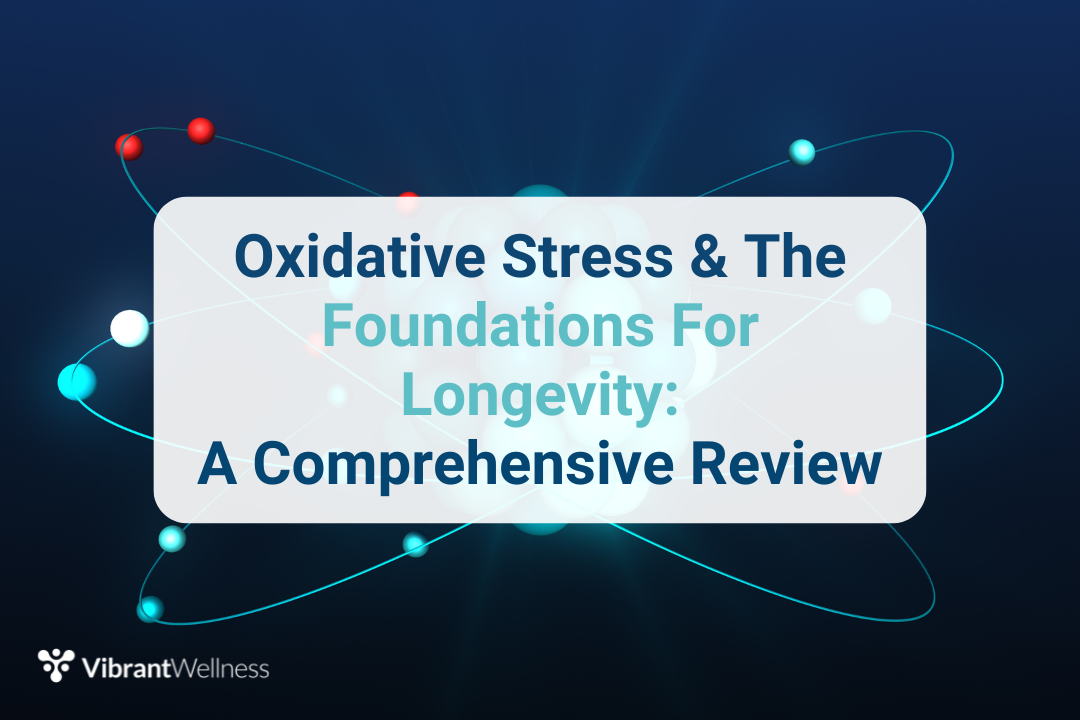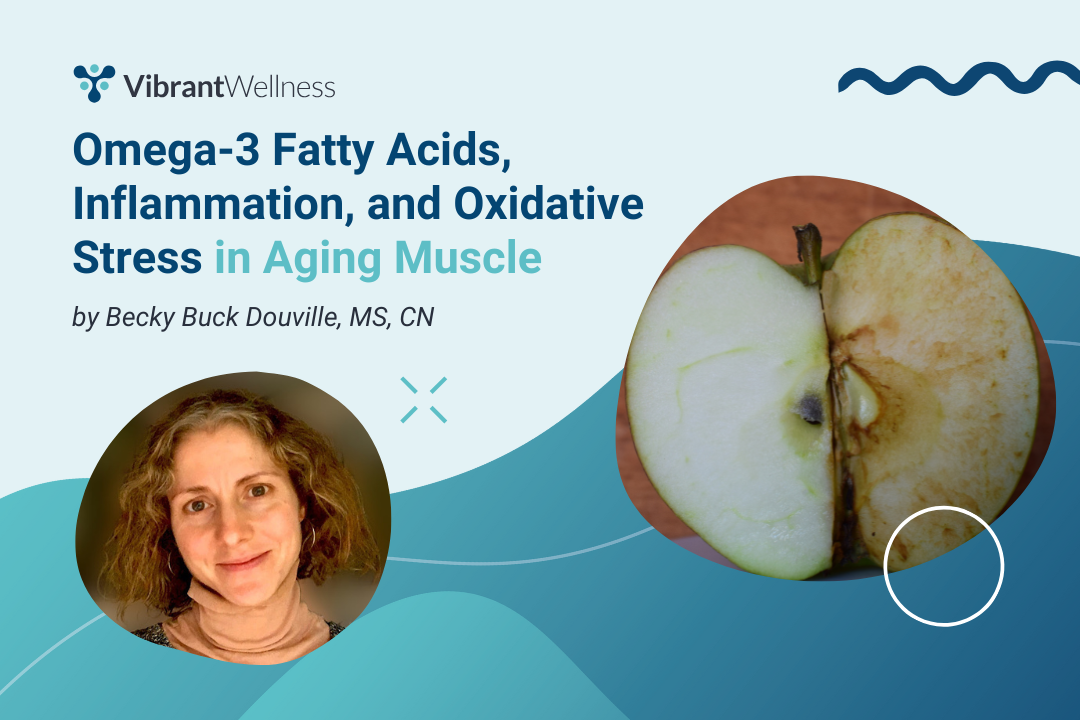How Oxidative Stress Influences Biological Aging
Oxidative stress is a crucial determinant of cellular function and longevity, representing the imbalance between free radicals and antioxidants in the body.
This imbalance leads to cellular damage and is a key factor in the aging process, but not just chronological age.
Through inflammatory processes and early development of age-related diseases, oxidative stress can cause biological aging—a deterioration of the body’s cells and tissues that doesn’t necessarily correlate to the number of years lived.
But what exactly causes oxidative stress, and why does it play such a pivotal role in aging?
This article explores how oxidative stress influences biological aging, plus diagnostic tools and strategies to reduce oxidative stress, slow down the aging process, and enhance longevity.
Table of Contents
The Science of Oxidative Stress & Aging
Understanding oxidative stress and its impact on aging reveals the reasons behind cellular wear and offers clues on slowing the aging process.
By examining the relationship between damaging free radicals and protective antioxidants, we can begin to understand the underlying causes of cellular deterioration and identify strategies for a healthier, longer life.
Understanding Oxidative Stress
.png?width=700&height=700&name=Oxidative%20Stress%20Posts%20(5).png)
Oxidative stress occurs when there's an imbalance between reactive oxygen species (ROS), reactive nitrogen species (RNS), and antioxidants within the body. These reactive species are collectively known as free radicals.
Free radicals are unstable molecules with an uneven number of electrons, allowing them to react with other molecules easily.
While these reactions are normal cellular processes, they can cause significant damage when free radicals outnumber antioxidants.
Antioxidants are molecules that can donate an electron to a free radical without becoming unstable themselves, thus neutralizing the free radical and preventing potential damage.
A balance between free radicals and antioxidants is vital for maintaining cellular function and overall health. However, excess free radicals or a deficiency in antioxidants leads to oxidative stress, damaging proteins, lipids, and DNA—contributing to cellular aging and dysfunction.1
Biological Age & Oxidative Stress
Research has consistently linked oxidative stress to accelerated biological aging.2
Biological age, as opposed to chronological age, reflects the physiological state of an individual's cells, tissues, and organs, essentially indicating how "old" these systems are in terms of function and resilience.
Oxidative damage accumulates over time, exacerbated by lifestyle factors, environmental exposures, and genetic predispositions, leading to increased cellular senescence and a decline in regenerative capacities.3
This accumulation not only influences the onset and progression of age-related diseases such as cardiovascular disease, diabetes, and neurodegenerative disorders but also affects the overall health span, the period of life spent in good health.
Studies show a direct link between mitochondrial oxidative stress (the primary source of oxidative stress) and a deteriorated health span.4
Thus, managing oxidative stress is essential in slowing biological aging and improving quality of life in later years.
The Impact of Oxidative Stress on Health
Oxidative stress is closely linked to health. It drives cellular damage and aging and triggers age-related diseases. Understanding its role highlights the importance of managing oxidative balance to prevent disease and promote well-being.
Cellular & Molecular Damage Linked to Oxidative Stress

Oxidative stress profoundly impacts cellular and molecular structures, including DNA, proteins, and lipids.
This damage plays a central role in the aging process and the functional decline of cells over time.
When free radicals outnumber antioxidants, they can attack important biomolecules, leading to oxidative damage.
DNA, the blueprint of cellular function, is particularly vulnerable to oxidative damage.5
ROS can damage DNA by causing mutations and base modifications that disrupt genetic information and integrity.
Through attacking the DNA base guanine, oxidative stress damages telomeres directly and accelerates telomere shortening, contributing to aging.
Additionally, oxidant species can also harm proteins and lipids.
Proteins, which perform critical functions such as catalyzing biochemical reactions and signaling, can become denatured or form harmful aggregates when oxidized.3
Lipids, particularly those comprising cell membranes, can undergo peroxidation, leading to deformation of cell structures—this process is associated with anomalies in cell metabolite transport that can affect physiological function.5
This cascade of damage disrupts cellular homeostasis and can accelerate aging, contributing to the decline in tissue and organ function.
Age-Related Diseases Linked to Oxidative Stress

The cellular and molecular damage oxidative stress inflicts accelerates the aging process, driving the onset of age-related diseases such as cardiovascular disorders, neurodegenerative diseases, diabetes, and inflammatory conditions.1
As we age, we’re more vulnerable to diseases like heart disease and neurological disorders. However, with accelerated biological aging, these conditions occur earlier on in the lifespan.
- Cardiovascular Diseases: Oxidative stress contributes to the development of cardiovascular diseases by promoting atherosclerosis (the buildup of fatty deposits in arteries), hypertension (high blood pressure)1, and myocardial infarction (heart attack). Oxidative damage to lipids, specifically low-density lipoprotein (LDL) cholesterol, plays a significant role in the initiation and progression of atherosclerosis.
- Diabetes: In diabetes, oxidative stress is both a cause and a consequence of insulin resistance and beta-cell dysfunction. High levels of free radicals can disrupt glucose metabolism, leading to hyperglycemia (high blood sugar levels) and further oxidative stress, exacerbating the condition.
- Neurodegenerative Diseases: Diseases such as Alzheimer's, Parkinson's, and Huntington's are associated with oxidative stress. The brain is particularly vulnerable to oxidative damage due to its high oxygen consumption and abundance of easily oxidizable fatty acids. Oxidative stress can lead to neuronal death and the accumulation of misfolded protein aggregates, characteristic of these diseases.
- Cancer: Oxidative stress can contribute to the initiation and progression of cancer by causing DNA damage, promoting mutations, and altering cellular signaling pathways.6 It can also affect tumor microenvironments, influencing cancer cell growth, metastasis, and resistance to therapy.
Assessing Oxidative Stress Markers
Understanding and measuring oxidative stress is pivotal to evaluating its impact on health and disease progression. Various methods exist for assessing oxidative stress markers, offering insights into the balance between free radicals and antioxidants in the body.
Direct Measurement of Free Radicals
Directly measuring free radicals presents significant challenges due to their highly reactive and transient nature.
Advanced techniques like Electron Spin Resonance (ESR) spectroscopy can detect specific types of free radicals, offering a direct but technically demanding approach to assessing oxidative stress.
Indirect Measurement of Damage Markers & Antioxidants
Given these challenges, research has shifted toward indirect methods, focusing on oxidative damage markers (e.g., lipid peroxidation products, protein carbonyls) and antioxidant levels.
These indirect markers provide a more reliable assessment of oxidative stress by measuring the aftermath of ROS/RNS activity or the body's defensive capacity against oxidative damage, circumventing the challenges associated with directly measuring reactive species themselves.

A highly effective way to measure indirect markers of oxidative damage is through precision testing, like Vibrant’s Oxidative Stress Profile.
This panel measures 16 markers of cumulative oxidative damage eliminated from the body in the urine, as well as 32 genetic variants that code for enzymes and antioxidants that can significantly impact the oxidative stress response.
This profile measures more oxidative damage markers than any known oxidative stress test, providing robust insight into oxidative damage to DNA, RNA, lipids, and proteins.
It’s also the only test that pairs markers of oxidative damage with genetic predispositions toward oxidative stress, allowing you to create personalized treatment plans that support the body's natural antioxidants (through dietary sources) for optimal antioxidant creation and recycling.

The Oxidative Stress Profile also includes a unique Oxidative Damage Score, which indicates the speed of biological aging based on oxidative damage to vital structures. This score elucidates the relationship between oxidative stress and biological aging and can help guide treatment plans.
Strategies to Manage Oxidative Stress

After identifying the degree of oxidative stress, the next step is to create treatment plans to reduce and manage this damaging form of inflammation.
Essential management strategies include:
- Reduce Toxic Burden: Environmental exposure to toxins, heavy metals, pollutants, and industrial chemicals can trigger oxidative stress by catalyzing ROS production, promoting free radical production, depleting antioxidants, and inhibiting their protective functions. Comprehensive tests like the Total Tox Burden can identify and help you reduce toxins contributing to oxidative stress.
- Focus on an Antioxidant-Rich Diet: Foods like berries, leafy greens, nuts, seeds, and vegetables contain a wealth of antioxidants that directly neutralize harmful free radicals in the body, reducing oxidative stress.
This array of dietary antioxidants supports the body's natural defense mechanisms, enhancing cellular health and preventing the oxidative damage contributing to aging and chronic diseases.
- Utilize Precision Supplements and Antioxidants: Personalized supplements can provide essential antioxidants and strengthen the body’s own antioxidant production. These can include non-enzymatic antioxidants such as coenzyme Q10, melatonin, vitamins A, C, E, and selenium.
- Embrace Polyphenols: Polyphenols, a diverse group of naturally occurring compounds found in plants, have been shown to decrease oxidative damage markers and increase antioxidant levels. Rich sources include fruits, vegetables, tea, coffee, wine, and chocolate, making them an accessible and effective way to combat oxidative stress.
- Adopt Healthy Lifestyle Habits: Smoking cessation, reduced alcohol intake, and quality sleep directly combat the accumulation of harmful free radicals, promoting cellular repair and balance. These adjustments are foundational to maintaining a healthy antioxidant-to-free-radical ratio, crucial for minimizing oxidative damage and supporting longevity.
- Understand the Dual Role of Oxidative Stress: While excessive oxidative stress is detrimental, moderate levels induced by optimal exercise can profoundly benefit health. Exercise activates hormesis, where exposure to mild stress triggers adaptive responses in cells and organisms, enhancing their resistance to higher stress levels and improving overall health and function. This strengthens the body's stress response mechanisms, improving durability and longevity.
The Biological Aging & Health Span Connection
.png?width=800&height=533&name=Untitled%20design%20(8).png)
Oxidative stress is inextricably linked to biological aging, serving as both a marker and a mechanism that drives the gap between our biological and chronological ages.
This dynamic underscores the complex interplay between environmental factors, lifestyle choices, and genetic predispositions that collectively influence our health and longevity.
As we uncover more about how oxidative stress impacts cellular integrity and function, its role in the onset and progression of age-related diseases becomes increasingly clear.
By enabling precise assessments of oxidative stress levels, diagnostic tools like the Oxidative Stress Profile can empower you to design personalized strategies for managing oxidative stress, potentially mitigating its effects on biological aging.
Looking forward, the continued exploration of oxidative stress and its implications for aging and health promises to yield innovative approaches to wellness, disease prevention, and the promotion of a healthier, more vibrant future for individuals at all stages of life.
Go Deeper
Want to learn more about how oxidative stress influences aging and longevity?
Read these next:
Oxidative Stress: The Key to Unlocking Longevity
Oxidative Stress & The Foundations for Longevity: A Comprehensive Review
The Critical Role of Oxidative Stress in Cardiovascular Health
References
- https://blog.vibrant-wellness.com/oxidative-stress-the-key-to-unlocking-longevity
- Inflammation, Oxidative Stress, and Age-Related Disease. (2016). Springer International Publishing. https://doi.org/10.1007/978-3-319-33486-8
- https://blog.vibrant-wellness.com/oxidative-stress-and-the-foundations-for-longevity-a-comprehensive-review
- Dai, DF., Chiao, Y.A., Marcinek, D.J. et al. Mitochondrial oxidative stress in aging and healthspan. Longev Healthspan 3, 6 (2014). https://doi.org/10.1186/2046-2395-3-6
- Yves J.R. Menezo, Erica Silvestris, Brian Dale, Kay Elder, Oxidative stress and alterations in DNA methylation: two sides of the same coin in reproduction, Reproductive BioMedicine Online,Volume 33, Issue 6, 2016, Pages 668-683, ISSN 1472-6483, https://doi.org/10.1016/j.rbmo.2016.09.006 (https://www.sciencedirect.com/science/article/pii/S1472648316305144)
- Yves J.R. Menezo, Erica Silvestris, Brian Dale, Kay Elder, Oxidative stress and alterations in DNA methylation: two sides of the same coin in reproduction, Reproductive BioMedicine Online, Volume 33, Issue 6, 2016, Pages 668-683, ISSN 1472-6483, https://doi.org/10.1016/j.rbmo.2016.09.006. (https://www.sciencedirect.com/science/article/pii/S1472648316305144)
The general wellness test intended uses relate to sustaining or offering general improvement to functions associated with a general state of health while making reference to diseases or conditions. This test has been laboratory developed and its performance characteristics determined by Vibrant America LLC and Vibrant Genomics, a CLIA-certified and CAP-accredited laboratory performing the test. The lab tests referenced have not been cleared or approved by the U.S. Food and Drug Administration (FDA). Although FDA does not currently clear or approve laboratory-developed tests in the U.S., certification of the laboratory is required under CLIA to ensure the quality and validity of the tests.
 By
By




